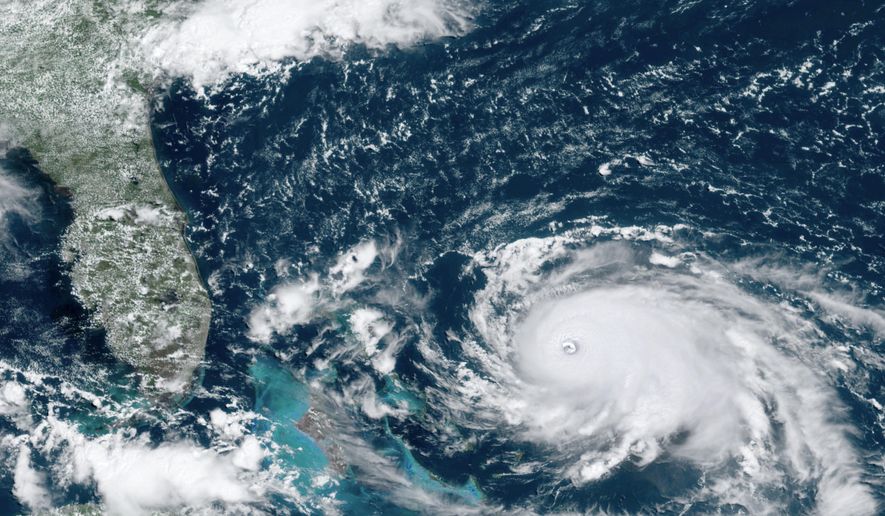Hurricane Dorian slammed into the Bahamas Sunday at Category 5 strength as debate raged over the Trump administration’s decision to divert disaster-relief funds to immigration enforcement.
Acting Homeland Security Secretary Kevin K. McAleenan sought to alleviate fears by declaring that the decision to shift $155 million from the Federal Emergency Management Agency to border enforcement would have “no impact” on the federal government’s preparedness.
“There will be no impact of the potential reprogramming on our ability to respond to this storm,” Mr. McAleenan told CBS’s “Face the Nation.”
“We believe we have fully adequate funding. And no money has actually been moved at this point to begin with.”
Acting FEMA Director Peter T. Gaynor agreed, saying federal agencies have “plenty of money and resources” to handle the 2017 and 2018 disaster recoveries, as well as Hurricane Dorian.
Such budget transfers are not uncommon — then-President Barack Obama did the same thing in 2014 with $277 million in FEMA funds — but Democrats have pilloried the administration for the budgetary shift.
SEE ALSO: Dorian damage in Bahamas called ‘devastating’
Democratic presidential hopeful Pete Buttigieg called it “unconscionable,” while Florida Agriculture Commissioner Nikki Fried tweeted President Trump “must be out of his mind if he thinks it’s a good idea to shift funds out of @FEMA for immigration detention at the border” with Hurricane Dorian looming.
“I’m really disappointed that President Trump has proposed taking money from FEMA in the middle of hurricane season for walls or cages or militarization of the border that we do not need,” said former Rep. Beto O’Rourke and presidential hopeful on CBS’s “Face the Nation.” “As president, I would fully fund FEMA.”
Mr. Gaynor downplayed the transfer’s significance.
“We live with risk every day, we assess risk, we assess that that $155 million is low risk and it is not affecting our preparedness whatsoever for Dorian,” he told “Fox News Sunday.”
Hurricane Dorian reached wind speeds of 185 mph as it descended on Elbow Cay in the Abaco Islands, with winds expected to reach 220 mph and storm surges forecast at 18 to 23 feet above normal, according to the National Hurricane Center.
Video and reports from the Bahamas suggested heavy damage in the archipelago, with roofs blown off, utility lines downed and floodwaters racing through the streets.
On parts of the island of Abaco, “you cannot tell the difference as to the beginning of the street versus where the ocean begins,” Bahamian Prime Minister Hubert Minnis told The Nassau Guardian, calling it “probably the most sad and worst day of my life to address the Bahamian people.”
The second strongest Atlantic storm on record, Dorian is expected to stall for about 24 hours over the Bahamas before heading for Florida, but the latest tracking models show the storm turning north and moving up the coast instead of crashing into Miami.
Even so, Mr. Gaynor warned residents living near the coast from Florida to North Carolina not to let up their guard.
“This has been a long duration storm, and it hasn’t even touched Florida or the East Coast,” Mr. Gaynor said. “Don’t dismiss this storm. We are not out of it. Life-threatening, dangerous surge, water, wind is coming your way. Take the time to prepare you and your family.”
Mr. Trump, who canceled a planned visit to Poland to oversee federal efforts, acted Sunday as the nation’s weatherman, tweeting Hurricane Dorian alerts and urging coastal residents to stay safe.
“Be careful! God bless everyone!” he tweeted in all capital letters.
“It’s one of the largest we’ve ever seen. Its effects will be felt hundreds of miles or more from the eye of the storm and long before it potentially makes landfall,” Mr. Trump said during a briefing at FEMA.
“We expect that most of the Eastern Seaboard will be ultimately impacted, and some of it very, very severely,” he said.
Mr. Gaynor said the president is receiving regular updates. “Daily. Hourly. If I’m not talking to his staff, we’re talking to him,” he said.
Several Florida counties and the city of Jacksonville issued partial evacuation orders for Monday, closing beaches and opening shelters.
South Carolina Gov. Henry McMaster ordered a mandatory evacuation of his state’s entire coast Sunday, affecting more than 800,000 people beginning noon Monday, when state troopers will start reversing lanes so that people can all head inland on major coastal highways, The Associated Press said.
Georgia Gov. Brian Kemp also ordered mandatory evacuations for that state’s Atlantic coast, also starting at midday Monday, the AP added.
Mr. McAleenan said the slow-moving storm is expected to bring rain, wind gusts and power outages to the coastline, even if the hurricane doesn’t make landfall.
“Most models show it stalling out about 60 miles offshore not making landfall,” Mr. McAleenan said on ABC’s “This Week.” “But that doesn’t mean it’s not dangerous. In fact, we expect hurricane-force winds to potentially hit the coast of Florida, and then a prolonged rain event, combined with a storm surge, that’s going to be very difficult as the storm starts to move northward.”
He added that the previous staffing shorting has been “fixed” and that “we are ready.”
“We have 3,000 people already deployed across federal agencies for this storm, about half of those are direct FEMA employees,” Mr. McAleenan said.
• Valerie Richardson can be reached at vrichardson@washingtontimes.com.




Please read our comment policy before commenting.